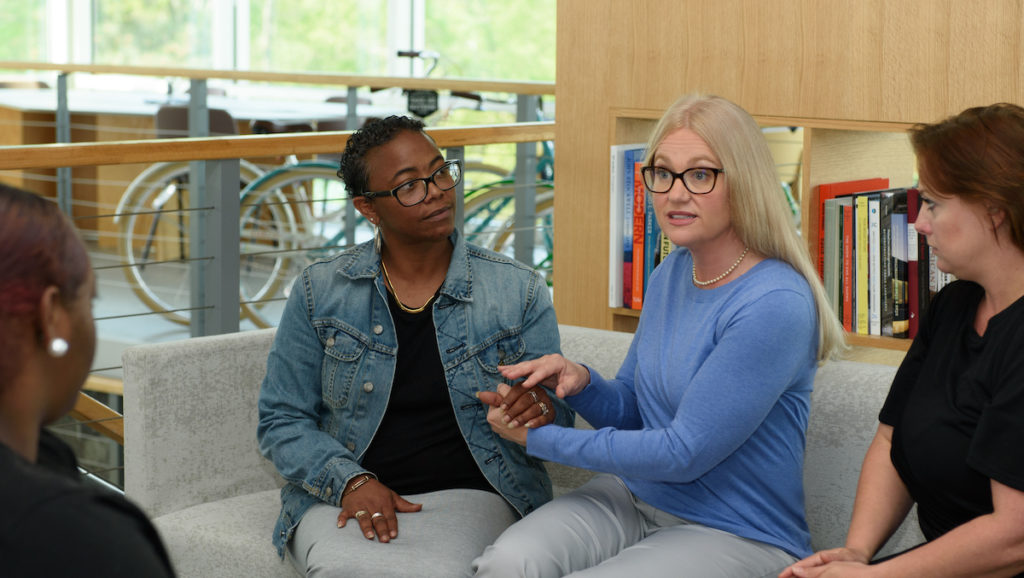Welcome to “Connecting the Dots“, a Partnerships for Health (PFH) blog dedicated to helping a diverse knowledge community tackle pressing dementia care challenges—collectively improving life for people living with the disease and a vast community of stakeholders. I’m Heather McKay, founder of Partnerships for Health and blog author. I’m excited to meet and learn more about you through our blog!
Connecting the dots is a useful metaphor for all kinds of writers ranging from foodies to science and technology gurus. The phrase “connect the dots” suggests a conscious effort to associate one idea with another, to reveal the “big picture.”

So what does “Connecting the Dots” mean to PFH?
PFH recognizes that challenges are inherent for those living with dementia, their caregivers, and the myriad stakeholders involved.
For instance, countless challenges facing families and professionals in the field include:
- Creating dementia-friendly environments
- Enhancing participation in meaningful activities
- Assisting with personal care
- Communicating to reduce distress
- Supporting grieving family members
- Adjusting interventions throughout the progression of dementia
- Developing policies and programs that support families adapting together
The upside to this situation is that with each challenge, the field is flooded with valuable resources regarding types, symptoms, and progression of dementia—as well as effective care strategies. [1]
However, despite ample resources for disseminating solutions to caregivers, information alone is inadequate to improve life for everyone involved. The resulting frustration we hear from families and professionals is, “Generic tips and tricks often fall flat in real-world situations, where dementia care doesn’t go by the book.” That’s where PFH comes in.
We seek to engage the whole dementia care community in a collaborative process of collecting knowledge (information, hands-on skills, and wisdom born of experience), sharing this knowledge with others, then calling on our collective expertise to resolve real dementia-related problems with teamwork. To us, that’s connecting the dots in dementia care.
What can you expect in “Connecting the Dots” posts?
Posts in this blog have a predictable flow designed to highlight common dementia-related challenges. Here is a summary of what to expect in the “Connecting the Dots” blogs:
- Naming the Challenge. Each post begins with a dementia-related challenge or key question posed by a dementia care partner.
- Gathering Information. In every post, we will gather data and context from a variety of sources both inside and outside the field of dementia care—including but not limited to researchers, medical professionals, experts from different fields, students, caregivers, and people living with dementia. We intentionally cast a broad net on the knowledge community to gather diverse information and perspectives on the problem, since a new “dot” often lends a new way of looking at the problem or a new idea to try.
- Success Stories. Then, we’ll share stories of adaptive caregivers who connected the dots in their own situation (combined their knowledge of the disease and other health factors, the people involved, the environment, their own past experiences, creativity, and teamwork) to resolve the challenge in real life.
- Practical Application. Despite common challenges, no two situations are completely alike, so we conclude each post with thought-provoking questions and additional resources to help you analyze your challenge in real life and integrate key techniques for success in your situation. By expanding your toolbox with new knowledge and skills and guiding you through the adaptive process, we hope that you will not only resolve your current dementia care challenges more easily but also feel more confident to meet inevitable future challenges.
Occupational therapists and scholars will recognize elements of the theoretical perspective Occupational Adaptation [2] in the blog, which undergirds my research with dementia care teams [3].
However, no prior knowledge or training is needed to enjoy and contribute to our blog.
As we call out the steps in each post (naming the challenge, gathering information, integrating it, and generating adaptive responses tailored for the situation), you’ll master the process in no time—and may even notice this common-sense style of active problem-solving benefits other areas of your life!
We invite collaboration! We invite you to visit, share, and comment on the blog here on our website and other social media platforms.
A salient lesson I learned from working with a curriculum development team at Duke University is that knowledge and skills are not the only dots we must connect—everyone in our knowledge community is a dot too! [4] In this style of collaborative, integrative learning, we’re connecting with each other to focus on our shared concern for enhanced dementia care.
And how better to connect with others than through storytelling? As the founder of PFH and the author of this blog, I will tell stories (and, yes, I’m bragging on my partners in the stories; it’s one of my favorite things to do)—and I invite your stories. In your comments, feel free to share what you’re still wrestling with as well as your successes. After all, no plan is guaranteed to work on the first attempt, and we know that learning is an unfolding process of trial and discovery.
Finally, I invite you to respond to each other with additional information or tips (connect more dots!) from your everyday experience or research. I’m totally confident that together, this community has more knowledge and expertise than any of us has alone.
So, if you’re up for the challenge and ready for some storytelling, let’s start Connecting the Dots!
[1] Gitlin, L. N., Marx, K., Stanley, I. H., & Hodgson, N. (2015). Translating evidence-based dementia caregiving interventions into practice: State-of-the-science and next steps. The Gerontologist, 55(2), 210-226. doi:10.1093/geront/gnu123
[2] Schultz, S. & Schkade, J. K. (1992). Occupational adaptation: Toward a holistic approach for contemporary practice, part 2. American Journal of Occupational Therapy, 46(10), 917-925.
[3] McKay, M. H., Pickens, N. D., Medley, A., Cooper, D., Evetts, C. L. (2020). Comparing occupational adaptation-based and traditional training programs for dementia care teams: An embedded mixed-methods study, The Gerontologist, pre-print online only, gnaa160, https://doi.org/10.1093/geront/gnaa160
[4] Hooper, B., Molineux, M., & Wood, W. (2020). The Subject-centered Integrative Learning Model: A new model for teaching occupational therapy’s distinct value. Journal of Occupational Therapy Education,4(2). (Journal of Occupational Therapy Education – http://encompass.eku.edu/jote). The publisher for Journal of Occupational Therapy Education is Eastern Kentucky University.


Leave a Reply